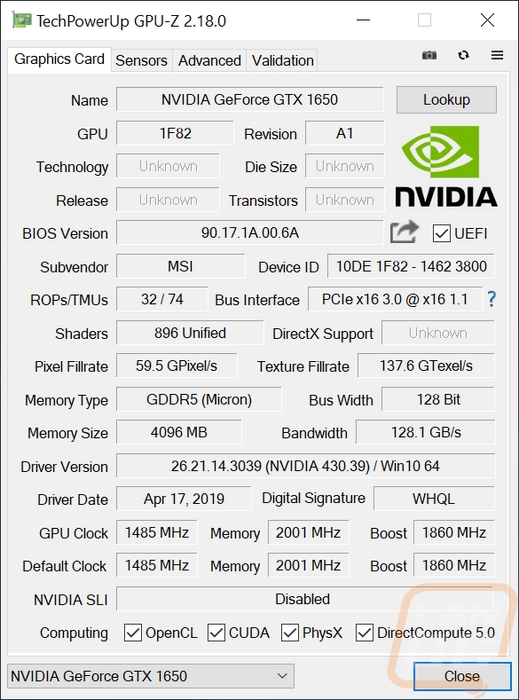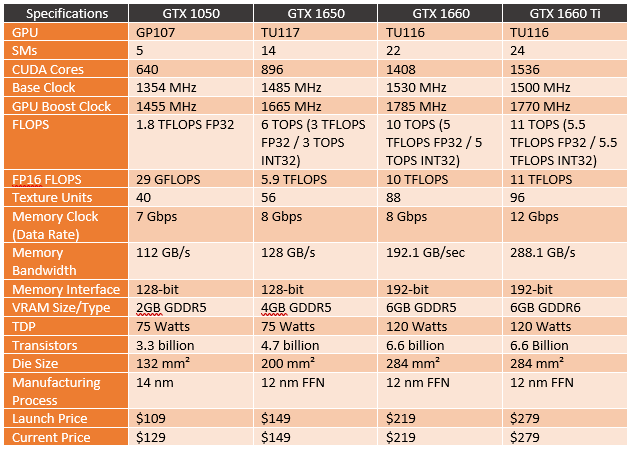So the GTX 1650 launched last week and I have been a little behind the curve on getting our card tested and reviewed. The new card follows the same naming of the GTX 1660 and GTX 1660 Ti which were launched in February and March respectively. The GTX 1650 is another Turing based GPU only this time based on the TU117 GPU and with a significantly lower TDP. Like the GTX 1660 and GTX 1660 Ti, there isn’t a Founders Edition of the GTX 1650 so today I will be checking out the MSI GTX 1650 Gaming X, an overclocked model.
Product Name: MSI GTX 1650 Gaming X
Review Sample Provided by: MSI
Written by: Wes Compton
Pictures by: Wes Compton
Amazon Affiliate Link: HERE
What is the GTX 1650 All About
Given the GTX 1660 and GTX 1660 Ti previously introduced, you can take a good guess on one big thing about the GTX 1650. This is another Turing based card as Nvidia is slowly filling in their lineup with their new architecture. The GTX 1650 does, however, use a new GPU die, the TU117 but it does still get at least some of the features that make Turing perform. You get the concurrent floating point and integer operations that really speed things up as well as the unified cache and larger L1 cache that lets the GPU better share cache. You also get adapter shading. Like the GTX 1660 and GTX 1660 Ti you don’t get the RTX features like the Tensor cores that provide AI processing or the RT cores for ray tracing, both which add a lot of size to the die and are only really feasible in the high-end cards right now. The GTX 1650 also has one other big change which is different than the GTX 1660. It does now have Turing's NVENC Encoder it uses Volta’s which comparable to Pascal’s encoder. This is used with programs like Plex and OBS for streaming for those of you wondering.
So what does the GTX 1650 have going on? Well here is a spec breakdown. I’ve got the GTX 1650 up next to the also new GTX 1660 and GTX 1660 Ti of course. Then for last generations model, which by the way are from all the way back in 2016, I have the GTX 1050 2GB model. So the GTX 1650 with its new TU117 GPU is running 14 SMs were the GTX 1660 has 22 which drops the CUDA core count down to 896 from 1408. This is over the 640 of the older GTX 1050. Clock speeds are lower than the GTX 1660 as well with those dropping from 1530/1785 MHz on the GTX 1660 down to 1485/1665 MHz. Together that puts the GTX 1650 well above the GTX 1050 in overall FLOPS with the FP32 TFOPS being rated at 3 over the older 1.8 but 2 under the 5 TFLOPS of the GTX 1660. As for memory the GTX 1650 is running the same 8 Gbps GDDR5 as the GTX 1660 but at a lower 4GB capacity. It is also running on a smaller interface with its 128-bit interface. This is what the GTX 1050 had but with twice the capacity and lower than the 192-bit interface on both GTX 1660 models.
TDP is a bit part of the GTX 1650, Nvidia stuck with 75 watts because this card was aimed to not have to run with a PCIe power plug, pulling power only from the PCIe slot. The GTX 1050 was the same way. Now the die size of the GTX 1650 is larger than the older GTX 1050 moving up from 132 mm² to 200 mm² and the transistor count went up with that as well from 3.3 billion to 4.7 billion with the 12nm FFN manufacturing process helping that as well. As for pricing, this new GPU has an MSRP of $149 which does leave room above it and below the GTX 1660 for the rumored GTX 1650 Ti. The GTX 1050 which is getting replaced here is up from its launch from of $109 to $129. I will have to check out performance before figuring out if that $149 price point is right. AMD's nearest competitor, however, is the RX570 which can be picked up for $129 so that should be interesting.
Now for my review, I am taking a look at the MSI GTX 1650 Gaming X which is MSI’s highest end model and with that has a higher clock speed. It is listed with a boost clock of 1860 MHz which is significantly higher than the 1665 MHz suggested clock and even higher than the GTX 1660 clock speed as well. To confirm everything was in line, before testing I checked and GPUz did show that same boost clock as well. I’ve included it below also to show the BIOS version used on the card and to show which driver I tested on which was the 430.39 launch driver.




